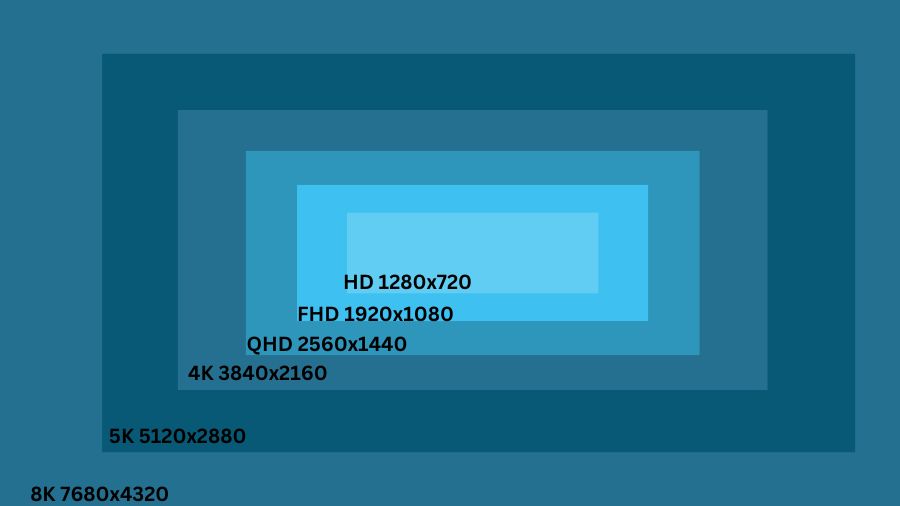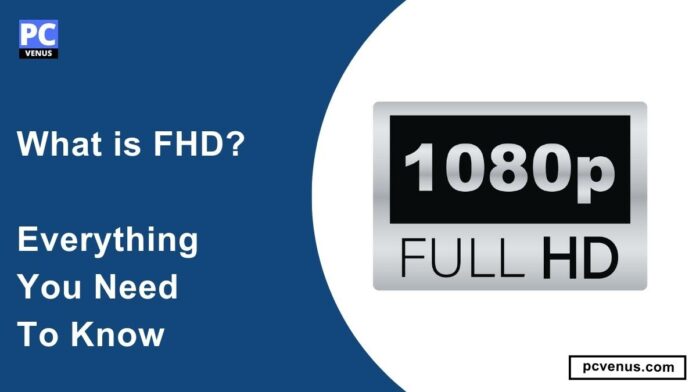In our digital age, screens are our windows to the world. Whether watching movies, working on important projects, or connecting with friends and colleagues, the quality of our visual experiences matters. Because the better the visual quality, the better things will look.
Full High Definition (FHD) technology has changed how we interact with screens, giving us crystal-clear visuals and vibrant colors. Due to this, it is enjoyable to watch things on the screen.
Definition of FHD
FHD stands for “full high definition” and is a standard used to describe television display technology and video quality, with a 1920 x 1080 pixels resolution and an aspect ratio of 16:9.
This resolution results in a clear, detailed and crisp image or video with a higher pixel density than HD displays.
History of Full HD
FHD (Full High Definition) started with TV experiments in Japan in 1989. By the early 2000s, FHD TVs became popular as they got cheaper and had more content.
In 2006, FHD computer monitors with clear displays became common. FHD gaming began in 2006; by the early 2010s, it was the norm.
In 2009, FHD displays came to high-end smartphones, becoming standard by 2012.
FHD security cameras with better resolution arrived in 2009 and were used in many places.
By 2012, FHD smart home devices had become popular among consumers.
FHD presentations started in 2006 at big events but became common at work and schools as FHD tech became more affordable.
Also Read:
Concept of FHD

Full HD uses a unique method to make pictures and videos look sharp. Instead of showing all the lines simultaneously, it alternately indicates one set of lines and another.
This means it needs two turns to show the complete picture. It does this by using a resolution of 1920 x 1080 pixels, which are tiny dots that make up the picture.
There are three types of HD: 720p, 1080i, and 1080p. Only 1080p is considered “full high definition.” The number “1080” in 1080p tells you how many lines make up the picture; more lines mean a sharper image. The ‘p’ in 1080p means the screen shows pictures using a ‘progressive scan.’ This method makes pictures look perfect because it quickly refreshes the screen with each frame.
Practical Uses for FHD
TV and Broadcasting
Nowadays, TV broadcasts are still in 720p or 1080i, with some satellite and cable providers offering content in 1080p, which is Full HD. A Full HD TV allows you to enjoy the highest quality broadcasts available.
The timeline of some of the key milestones in the development of FHD TV and broadcasting:
| Years | Availability |
|---|---|
| 1989 | Regular daily FHD TV broadcasts begin in Japan |
| 1994 | First commercial FHD TVs go on sale in Japan |
| 1996 | First FHD TV broadcasts made in the US |
| 1998 | First commercial FHD TVs go on sale in the US |
| 2000s | FHD TVs have become more affordable and FHD content has become more widely available |
| 2010s | FHD TVs have become more affordable, and FHD content has become more widely available |
| 2020s | FHD TVs have become the standard for most consumers |
2. FHD in Monitors
Full HD monitors (1920 x 1080p) are standard for computer screens and TVs. They provide sharper and clearer images with vibrant colors, making them suitable for general use and basic gaming.
The timeline of some of the key milestones in the development of FHD monitors:
| Year | Availability |
|---|---|
| 2006 | FHD monitors become more affordable |
| 2008 | FHD monitors have become more affordable |
| 2010s | FHD monitors become available in various sizes and prices |
| 2020s | FHD monitors have become available in various sizes and prices |
3. FHD in Gaming
Most video game systems and monitors these days come with Full HD resolution. It offers an intense gaming experience with clear graphics and vibrant colors.
The timeline of some of the key milestones in the development of FHD gaming:
| Years | Availability |
|---|---|
| 2006 | First FHD games released, such as “Crysis.” |
| 2007 | FHD gaming has become the standard for most gamers, as classics like “Grand Theft Auto IV” showcase the benefits of higher resolution. |
| 2008 | FHD gaming remains the most common resolution, but UHD (Ultra HD) gaming is becoming more popular, with games like “Cyberpunk 2077” pushing the boundaries of visual fidelity on UHD displays. |
| 2010s | Most new games are released with FHD support, making titles like “The Witcher 3: Wild Hunt” a visual feast on FHD screens. |
| 2020s | FHD gaming remains the most common resolution for gaming, but UHD (Ultra HD) gaming is becoming more popular, with games like “Cyberpunk 2077” pushing the boundaries of visual fidelity on UHD displays. |
4. FHD in Mobile Phones
The smartphone’s Full HD screen (1080p) provides an excellent viewing experience for videos, games, and online tasks. They provide clear, sharp visuals without straining the eyes while reading, watching videos, and playing graphics-intensive games.
| Years | Avalaibilty |
|---|---|
| 2009 | FHD displays have become the standard for most high-end mobile phones, with the Samsung Galaxy S3 showcasing a Super AMOLED FHD screen. |
| 2010 | FHD displays become more common in high-end mobile phones, with models like the HTC Desire HD featuring FHD screens. |
| 2011 | FHD displays become the standard for most flagship mobile phones, with the iPhone 4S offering a Retina Display as an example. |
| 2012 | FHD displays become the standard for most high-end mobile phones, with the Samsung Galaxy S3 showcasing a Super AMOLED FHD screen. |
| 2013-present | FHD displays remain the standard for most mobile phones, with popular devices like the iPhone 12 featuring FHD screens. However, UHD (Ultra HD) displays are becoming increasingly popular in high-end mobile phones, with models like the Samsung Galaxy S21 offering stunning UHD visuals. |
5. FHD in Presentations
When giving presentations or using a projector, FHD resolution ensures that your slides and visuals are clear and legible to your audience, even in large conference rooms.
| Years | Availability |
|---|---|
| 2006 | FHD presentations started, but they were expensive and mainly for big events. |
| 2010s | FHD presentations became common in business meetings as technology got cheaper. |
| Today | FHD presentations are standard in work and school. They make things clearer, and it’s easy to use FHD tech for presentations. |
6. FHD in Security Surveillance
FHD resolution is valuable in security and surveillance systems, accurately identifying people and objects in video footage.
| Years | Availability |
|---|---|
| 2009 | The first FHD security cameras came out, giving clearer pictures. For instance, the Sony SNC-CH280 was one of them. |
| 2010 | FHD security cameras became cheaper, so more people could afford them. Cameras like the Hikvision DS-2CD2032-I were well-liked for being affordable and having FHD quality. |
| 2011 | FHD security cameras became the usual choice for businesses and industries, improving surveillance. Companies like Axis Communications offer a range of FHD cameras for different uses. |
| 2012-present | FHD security cameras are now used in many places like homes, businesses, schools, and government buildings. Brands like Arlo and Ring made FHD security cameras famous for houses, while companies like Dahua and Bosch offer FHD options for bigger places. |
7. FHD in Home Automation and Smart Devices
FHD screens in smart home devices, like smart thermostats and security cameras, provide users with clear and actionable information.
Examples of FHD home automation and smart devices:
- Security cameras
- Video doorbells
- Thermostats
- Smart TVs
- Smart speakers
- Smart displays
- Smart home hubs
| Years | Availability |
|---|---|
| 2012 | FHD home automation and smart devices have become more affordable, making them accessible to more people. |
| 2013 | FHD home automation and smart devices became more affordable, making them accessible to more people. |
| 2014 | The first FHD home automation and smart devices, like high-definition security cameras and smart thermostats, were introduced. |
| 2015-present | FHD home automation and smart devices continue to be the standard, but UHD (Ultra HD) smart devices are gaining popularity. |
Also Read: What is UHD?

Advantage of FHD
Sharpness
FHD screens provide sharp and clear views; they reduce pixelation and make photos and videos look clear even when viewed at close range.
Vibrant Colors
The FHD display displays colors accurately, resulting in vivid and vibrant images that enhance the viewing experience.
Multitasking
The enlarged screen of FHD monitors allows real estate users to multitask while improving productivity.
Entertainment Quality
FHD screens make watching movies and gaming more immersive with their detailed graphics and vibrant colors, making it even more fun for us to do.
Professional Applications
FHD has become a preferred choice for design, photography, and video editing professionals due to its accuracy and detail.
Compatibility
FHD is widely supported across various devices, ensuring you enjoy high-quality content on multiple screens.

FHD vs. Other resolution
| Resolution | Abbreviation | Pixel Count | Aspect Ratio | Notable Uses |
|---|---|---|---|---|
| 4K (Ultra HD) | UHD or 4K | 3840×2160 | 16:9 | Ultra HD TV, gaming, video production |
| QHD (Quad HD) | QHD | 2560×1440 | 16:9 | High-end smartphones, computer monitors, gaming |
| FHD (Full HD) | FHD | 1920×1080 | 16:9 | TV, gaming, video streaming, office work |
| HD (High Definition) | HD | 1280×720 | 16:9 | TV, streaming content, video conferencing |
| 8K (Full Ultra HD) | FUHD or 8K | 7680×4320 | 16:9 | High-end displays, future-proofing, 8K content |
Final Word
Full High Definition (FHD) is the magic behind our screens today. This makes pictures and videos extremely clear as if they are coming straight out.
FHD isn’t just about pixels; It’s all about making everything look excellent and precise on our screens.
This technology will always keep our screens looking great, no matter what new comes along. That’s why people prefer devices with FHD screens.




